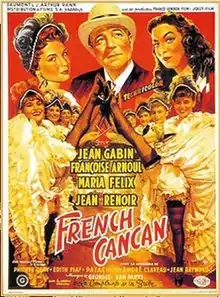| French Cancan | |
|---|---|
 Theatrical release poster | |
| Directed by | Jean Renoir |
| Written by | Jean Renoir André-Paul Antoine |
| Produced by | Louis Wipf |
| Starring | Jean Gabin Françoise Arnoul María Félix |
| Cinematography | Michel Kelber |
| Edited by | Borys Lewin |
| Music by | Georges Van Parys |
| Distributed by | Gaumont Film Company Criterion Collection |
Release date | 9 April 1955 |
Running time | 104 minutes |
| Countries | France Italy |
| Language | French |
| Box office | 4,075,306 admissions (France)[1] |
French Cancan (also known as Only the French Can) is a 1955 French-Italian musical film written and directed by Jean Renoir and starring Jean Gabin and Francoise Arnoul. Where Renoir's previous film Le Carosse d’or had celebrated the 18th-century Italian commedia dell’arte, this work is a homage to the Parisian café-concert of the 19th century with its popular singers and dancers. Visually, the film evokes the paintings of Edgar Degas and the Impressionists, including his own father, Pierre-Auguste Renoir.[2] It also marked his return to France and to French cinema after an exile that began in 1940.[3]
It was shot at the Joinville Studios in Paris. The film's sets were designed by the art director Max Douy.
Plot
In Paris in the 1890s, Henri Danglard owns a night club where the star turn is a belly dance by his mistress Lola. Going after the show one night to an old-fashioned dance hall in Montmartre, he sees people doing the cancan together and is struck by the suppleness and charm of a young laundry girl called Nini. He persuades her to take dancing lessons for a new venture he is planning. As his club has failed and Lola has left him, his idea is to open another place with a troupe of glamorous girls performing the cancan. Naming it the Moulin Rouge, its opening night is a thunderous success.
Cast
- Jean Gabin as Henri Danglard
- Françoise Arnoul as Nini
- María Félix as Lola
- Anna Amendola as Esther Georges
- Jean-Roger Caussimon as Baron Walter
- Dora Doll as La Génisse
- Giani Esposito as Prince Alexandre
- Gaston Gabaroche as Oscar, le pianiste
- Jacques Jouanneau as Bidon
- Jean Parédès as Coudrier
- Franco Pastorino as Paulo, le boulanger
- Michèle Philippe as Eleonore
- Michel Piccoli as Le Capitaine Valorgueil
- Albert Rémy as Barjolin
- Philippe Clay as Casimir le Serpentin
- Édith Piaf as Eugénie Buffet[4][5]
- Pierre Olaf as Roberto, pierrot siffleur[6]
Critical reception
François Truffaut reviewed the film in Arts magazine in May 1955 and called it a milestone in the history of colour of cinema. "Every scene is a cartoon in movement [-] Madame Guibole's dance class reminds us of a Degas sketch." Whilst Truffaut did not consider it as important a film as Rules of the Game or The Golden Coach, he nevertheless praised it as an example of Renoir "as vigorous and youthful as ever." This affirmative response was not shared by Bernard Chardère however, writing in Positif, who criticised the music, the sets, even the final cancan scene. "The phoniness of the rue Lepic, with its vegetable carts and piles of artificial stones is painful to look at. The actors act. The audience gets bored. The dance rehearsals are Degas all right, but the kind that appears on Post Office calendars."[7]
The film received the Grand Prix de l'Academie du Cinéma in 1956.[8] Roger Ebert added French Cancan to his "Great Movies" list in 2012.[9]
References
- ↑ "French CanCan". Box Office Story.
- ↑ Beranger, Jean; Garey, Howard B. (1956). "The Illustrious Career of Jean Renoir". Yale French Studies (17): 27–37. doi:10.2307/2929115. JSTOR 2929115.
- ↑ Bergstrom, Janet (1996). "Jean Renoir's Return to France". Poetics Today. 17 (3): 453–489. doi:10.2307/1773418. JSTOR 1773418.
- ↑ Robertson Wojcik, Pamela (2001). Soundtrack available: essays on film and popular music, Duke University Press. p. 137. ISBN 0-8223-2800-3
- ↑ Crosland, Margaret (2002). A cry from the heart: the life of Edith Piaf, Arcadia. ISBN 1-900850-50-8
- ↑ Ronald Bergan (22 September 1995). "Pierre Olaf: Surreal world of a pierrot". The Guardian. p. 17.
- ↑ Truffaut,Arts, May 4, 1955, and Chardere in Positif, quoted in French New Wave, by Jean Douchet, p.27
- ↑ Faulkner, Christopher (1979). Jean Renoir, a guide to references and resources. Boston, Mass: G.K. Hall & Company. p. 33.
- ↑ Roger Ebert. French Cancan May 31, 2012
External links
- French Cancan at IMDb
- French Cancan at AllMovie
- French Cancan an essay by Andrew Sarris at the Criterion Collection